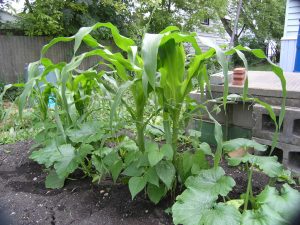5.6 Nitrogen Fixers and Traditional Growing Practices
Hannah Nelson and Christelle Sabatier
Learning Objectives
- Identify where plants obtain water and nutrients and the role of active transport in directional movement.
Nitrogen Fixing
Plants require nitrogen for the formation of nucleic acids and proteins. Nitrogen, therefore, is one of the most important macronutrients for plant life. Atmospheric nitrogen, the diatomic molecule N2 ( dinitrogen), is the largest pool of nitrogen in terrestrial ecosystems. However, plants cannot take advantage of this nitrogen because they do not have the necessary enzymes for conversion into biologically useful forms. nitrogen can however be “fixed,” which means that it can be converted to ammonia (NH3) through biological, physical, or chemical processes. As you have learned, biological nitrogen fixation (BNF) is the conversion of atmospheric nitrogen (N2) into ammonia (NH3), exclusively carried out by prokaryotes such as soil bacteria or cyanobacteria. Biological processes contribute 65% of the nitrogen used in agriculture. The following equation represents the process:
N2+16 ATP + 8 e− + 8 H+ 2NH3 + 16 ADP + 16 Pi + H2
The most important source of BNF is the symbiotic interaction between soil bacteria and legume plants, including many crops important to humans (Figure 5.6.1). The NH3 resulting from fixation can be transported into plant tissue and incorporated into amino acids, which are then made into plant proteins. Some legume seeds, such as soybeans and peanuts, contain high levels of protein, and serve among the most important agricultural sources of protein in the world.

Soil bacteria, collectively called rhizobia, symbiotically interact with legume roots to form specialized structures called nodules, in which nitrogen fixation takes place. This process entails the reduction of atmospheric nitrogen to ammonia, by means of the enzyme nitrogenase. Therefore, using rhizobia is a natural and environmentally friendly way to fertilize plants, as opposed to chemical fertilization that uses a nonrenewable resource, such as natural gas. Through symbiotic nitrogen fixation, the plant benefits from using an endless source of nitrogen from the atmosphere. The process simultaneously contributes to soil fertility because the plant root system leaves behind some of the biologically available nitrogen (Figure 5.6.2).

The Three Sisters: Native Growing Practices
Native populations in the Americas for hundreds of years have cultivated the Three Sisters plants: corn, beans, and squash. These plants in conjunction with one another save as an ecologically beneficial and traditional planting method that sustains agricultural systems in a multitude of ways. The plants compliment each other by providing mutually beneficial outcomes. Corn provides structure for beans to latch and grow off of, beans supply soil with nitrogen, and squash due to its heavy ground cover reduces weeds while maintaining healthy water levels in the soil. This practice can also be referred to as companion planting. Such a method supports biodiversity, increases fertility of soil, and reduces requirement of external nutrients that larger farms might use (i.e., chemical rich fertilizers or pesticides).
Decolonized approaches to farming center around honoring land by working with its natural ecosystem, rather than forcing a new one. The three sisters have maintained food security for innumerable communities over time.

Watch the video below to learn about microbiologist Dr. Kiana Frank, who is making connections between nitrogen cycling in microbes and Native Hawaiian culture. You can learn more about Dr. Frank’s laboratory at Kewolo Marine Laboratory.
Video 5.6.1. Nitrogen Cycling by Microbes in Native Hawaiian Culture | Decoding Ancestral Knowledge by Science Communication Lab
Practice Questions
Glossary
nitrogen fixation
the conversion of nitrogen gas (N2) into ammonia (NH3)
Figure Descriptions
Figure 5.6.1. Three panel image showing different edible legumes including, from left to right, peanuts in a white bowl, red kidney beans, and dried chickpeas. [Return to Figure 5.6.1]
Figure 5.6.2. The figure compares whole roots to a cellular close-up. Panel (a) shows pale yellow soybean roots on a dark background with many small, bead-like nodules dotting the roots; a label identifies them as nitrogen-fixing nodules. Panel (b) is a grayscale transmission electron micrograph of tissue from a nodule cell. Several oval vesicles appear as light rings, each containing a darker, bean-shaped bacterium (Bradyrhizobium japonicum); arrows point to these vesicles, and a scale bar at lower right reads 100 nm. Together, the panels illustrate that soybean roots form nodules and that, inside nodule cells, the nitrogen-fixing rhizobia are housed within membrane-bound vesicles. [Return to Figure 5.6.2]
Figure 5.6.3. Corn stalks, climbing beans, and broad-leaf squash sharing one bed. [Return to Figure 5.6.3]
Media Attributions
- 1A.B.ediblelegumes
- 1A.B.soybeanroot
- 1A.B.threesisters
